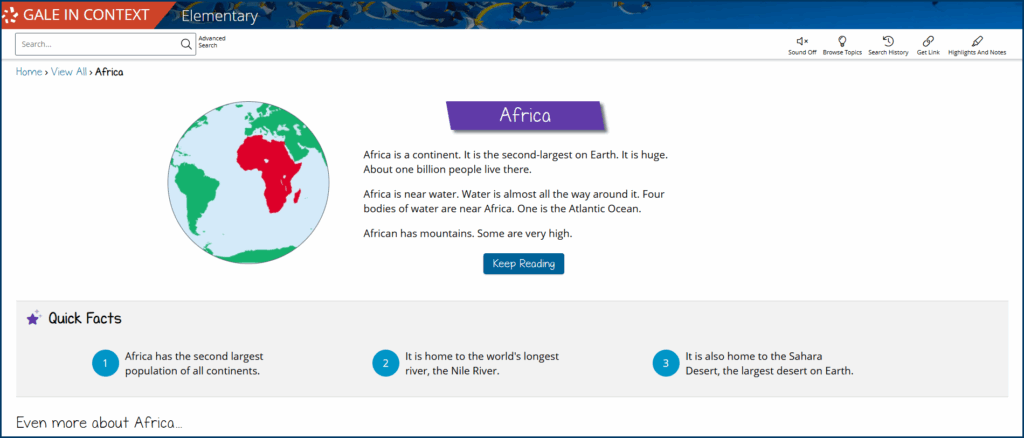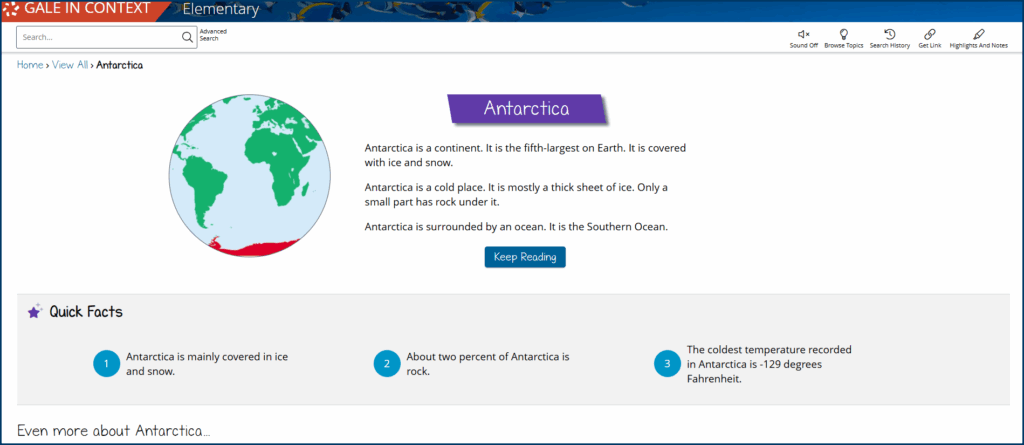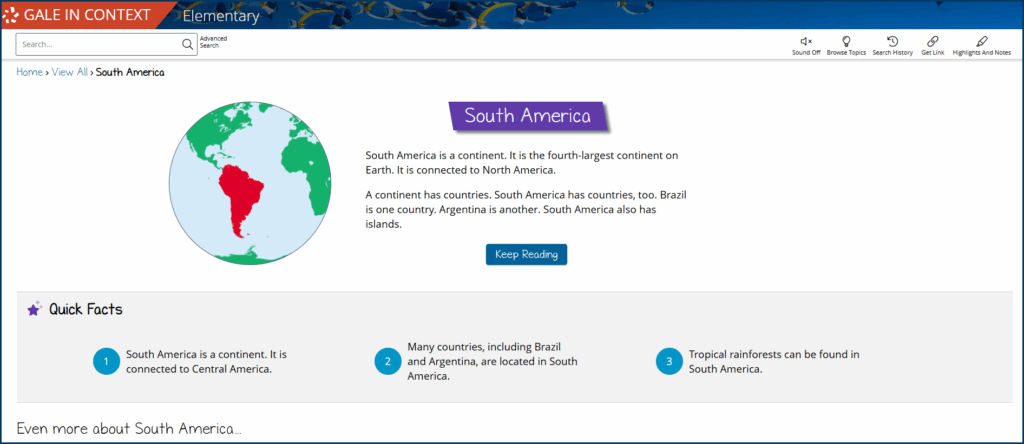| By Gale Staff |
The Earth is a remarkable planet. Due to its unique position relative to the Sun, it is well-suited to support life. Earth’s temperate climate allows for liquid water on its surface, which covers more than 70% of the globe. The remaining fraction, of course, is land, spread across seven distinct continents and shared among more than eight billion people.
With Gale In Context: Elementary, educators can balance the Earth’s enormous scale with age-appropriate materials concerning its geography, plants, animals, and, of course, the human inhabitants who call it home. Each continent has its own portal, featuring a range of dynamic content, including fascinating statistics, colorful maps, engrossing cultural articles, and vibrant wildlife images.
In addition to Gale’s curated content, educators can rely on our comprehensive accessibility features, including adjustable fonts, embedded text-to-speech software, and reading level options to accommodate learners’ needs. With these built-in tools, you can spend less time providing individualized support and instead get creative as you develop lesson plans that travel through the seven continents! Gale In Context: Elementary provides a valuable, kid-friendly learning environment that embraces the rich details of our world.
Africa
Africa is the second-largest continent, comprising 54 countries—more than any other continent, with Asia coming in second at 49. There is so much to explore across Africa, including an incredible wealth of cultural and linguistic diversity, spanning more than 800 people groups and approximately 2,000 languages.
Africa is known as the Cradle of Humankind because scientists believe that the human species likely originated there. Artifacts and bones from ancient humans include the 1974 discovery of “Lucy,” named after the Beatles’ “Lucy in the Sky with Diamonds,” which played while the crew was working. Discovered in Ethiopia, Lucy’s remains are incredibly well preserved and can help us better understand what life was like for our ancestors.
Africa is home to a treasure trove of early fossils that describe the story of our species. Across the continent, scientists have discovered significant milestones in human adaptation, including increased brain size and the development of tool use. They have also found evidence of early humans experimenting with fire and eventually migrating beyond Africa’s borders.
Recent archaeological and paleontological discoveries continue to shape our understanding of our species—including the discovery of thousands of bones in South Africa’s Rising Star Cave in 2013. Africa is undeniably critical to our success as a species. Its climate and extensive biodiversity helped our ancestors to adapt and thrive.
Did You Know?
The Sahara Desert is huge! It’s the largest non-polar desert on the planet, and larger than the continental United States.
Antarctica
With temperatures recorded as low as -129° Fahrenheit and the majority of its landmass covered by ice, Antarctica is the coldest place on Earth. The thickness of the continent’s ice sheet averages 2.16 kilometers—that’s more than 7,000 feet! Surrounded by the treacherous Southern Ocean and battered by unforgiving winds upward of 200 miles per hour, information about Antarctica’s existence was mostly speculative until the early 19th century.
Despite the presence of ice and snow, Antarctica is technically a desert, since the region gets very little precipitation throughout the year. The reflectivity of the landscape’s ice makes sunlight especially intense, causing sunburn and eye damage.
In 1959, 12 nations came together in a spirit of diplomacy to form the Antarctic Treaty, which outlined a peaceful, collaborative approach to shared scientific research throughout the frozen continent. Working in Antarctica is extremely dangerous, so scientists from different backgrounds and nationalities participate in joint projects, sharing expertise and vital resources.
Today, several countries have year-round stations on the southernmost continent. Scientists spend several months at a time conducting valuable research and making observations about this rare ecosystem.
Did You Know?
In 2017, an iceberg the size of Lake Erie broke off the coast of Antarctica!
Asia
Asia is the world’s largest and most populous continent. Approximately half of the global population resides in Asia, which includes 49 countries and hundreds of unique languages, religions, and cultures. Asia is home to the world’s tallest mountain, Mount Everest, and its largest lake, the Caspian Sea.
While Africa may be considered the Cradle of Humankind, the Asian continent is regarded as the Cradle of Civilization. As early humans migrated northward from Africa into the Middle East, they began to develop agricultural and writing systems. Later innovations included paper, the magnetic compass, and gunpowder, as well as sophisticated crafts such as silk and porcelain.
These products spurred trade throughout the continent (and beyond) via the Silk Road from its inception in 130 B.C.E. until the Ottoman Empire shut it down in 1453 C.E. This collection of trade routes stretched thousands of miles across Asia through places like modern-day Jordan and Mongolia, facilitating financial and cultural exchanges between the East and West.
Today, people across Asia continue their legacy of innovation and trade. China, Japan, and South Korea have all played crucial roles in the technological advancements of the past century. Asian companies have helped create everything from PlayStation and laptops to QR codes and emojis. Some of the most successful businesses in the world are headquartered in Asia, providing a significant driver for the modern global economy.
Did You Know?
Asia contains both the highest and lowest points on the planet? Mt. Everest reaches an incredible 29,028 feet, while the Dead Sea, straddling the border of Israel and Jordan, is 1,310 feet below sea level.
Australia
Australia is both a country and a continent. Home to 14 island nations, the continent is sometimes also referred to as Oceania.
This corner of the globe has some seriously cool animals. Gale In Context: Elementary features comprehensive animal facts and captivating images of Australian wildlife, which has evolved in somewhat unusual ways because of the continent’s isolation. Most of its species are endemic, meaning you can only find them in nature in Australia.
One of the most notable Australian species is the kangaroo—it’s even on Australia’s official seal! These fascinating marsupials can reach heights of more than 6 feet and jump distances of up to 20 feet. Marsupials are one of the rare mammals that uses a pouch during their reproductive process. Baby kangaroos, called joeys, have a short gestation period before an extended developmental period within the mother’s pouch.
Another marvelous marsupial is Australia’s koala bear. Just like the kangaroo, mother koalas carry their young within a small pouch near their abdomen. Koalas are known for their adorable features and tendency to sleep up to 20 hours each day. Their diet, which predominantly consists of eucalyptus leaves, provides very little energy, making them lethargic and reserved.
There’s even more to explore in Australia. From the thousands of coral and fish species that inhabit the Great Barrier Reef to the continent’s peculiar platypuses and deadly snakes, Australia presents a truly captivating and adventurous unit.
Did You Know?
After Vatican City, the least populated country in the world can be found in Australia. The small nation of Tuvalu covers nine islands, and is home to approximately 11,000 people.
Europe
After Australia, Europe is geographically the second smallest continent. However, with more than 40 countries, spanning a range of cultural traditions and diverse geography, the continent is home a wealth of distinct national and regional cuisines.
French cuisine is globally renowned, defined by its richness and simple yet elegant presentation. Throughout much of the Middle Ages, France was embroiled in some form of conflict or famine. Its people, therefore, relied on fresh, local ingredients available within their immediate borders, such as butter, wine, herbs, and root vegetables. They developed an art form for simple, rustic preparations with minimal waste.
Italian food is equally beloved, especially in the United States. Of course, there’s far more to Italian cuisine than pizza and spaghetti. Much like the French, Italians emphasize fresh, locally-sourced ingredients and simple, traditional recipes. Dishes tend to feature tomatoes, indulgent olive oils, basil and other herbs, lemons, and of course, regional cheeses.
European gastronomy has a long, proud history defined by freshness and local sourcing. To ensure their diet honors these values and traditions, Europe imposes strict regulations on many foods, ensuring fewer additives and higher-quality ingredients.
Did You Know?
Tomatoes, a critical ingredient for pizza and pasta sauces, weren’t introduced to Italian cuisine until after their discovery in the Americas.
North America
North America is the third-largest continent, encompassing Canada, the United States, Mexico, Central America, and island nations such as Cuba, Greenland, and Haiti. It spans from the Arctic Circle to just above the equator.
Following colonization by France, Spain, and Great Britain, most people in North America speak French, Spanish, or English. However, different languages are still spoken or signed throughout the continent, including upward of 175 Native American languages. Many common English words, like “barbecue” or “raccoon,” actually come from Indigenous vocabulary. Many U.S. states and Canadian provinces can trace their names to Indigenous languages, such as the Alabama tribe from the Creek Confederacy or the Algonquin word “Quebec,” meaning “narrow passage.”
Many North American languages have been lost over time. Yet, there are ongoing efforts to preserve and protect traditional languages and the knowledge they contain.
Did You Know?
Although Christopher Columbus is sometimes credited as the first European explorer to visit North America, the Vikings beat him—by about 500 years! North America’s first-known European settlement is in L’Anse aux Meadows in present-day Newfoundland.
South America
Connected to North America by the narrow Isthmus of Panama, South America has extraordinary biodiversity. Some scientists estimate that, due to its diverse climate zones and vibrant geography, South America has the highest number of animal species of any continent.
The Andes Mountains, which stretch along South America’s western coast, are the longest continental mountain range in the world. Many of its peaks are covered in snow year-round, and others are active volcanoes. The world’s highest volcano, Ojos del Salado, straddles the border between Chile and Argentina. Colorful animals like toucans and flamingos live in the Andes, as does the mysterious spectacled bear.
The Amazon Rainforest, covering much of the northern half of the continent, is home to 10% of the Earth’s known species. Millions of birds, insects, mammals, and plants thrive in this unbelievable ecosystem. The Amazon River, the world’s largest river, flows from the Andes Mountains through the rainforest and into the Atlantic Ocean.
Protecting the continent’s biodiversity is challenging, given deforestation and the increasing demand for natural resources. However, the Amazon Rainforest plays a crucial role in the planet’s health, as its dense flora absorbs significant amounts of carbon from the atmosphere.
Did You Know?
The world’s highest waterfalls are in South America! Located in Venezuela, Angel Falls plummets an astonishing 800 meters (2624 feet).
Gale In Context: Elementary helps bring our massive and complex planet down to scale, providing a safe, ad-free environment for students to be curious about the world around them. If your school is not a Gale subscriber, contact your local representative to learn more about our products and request a trial.








